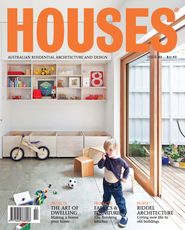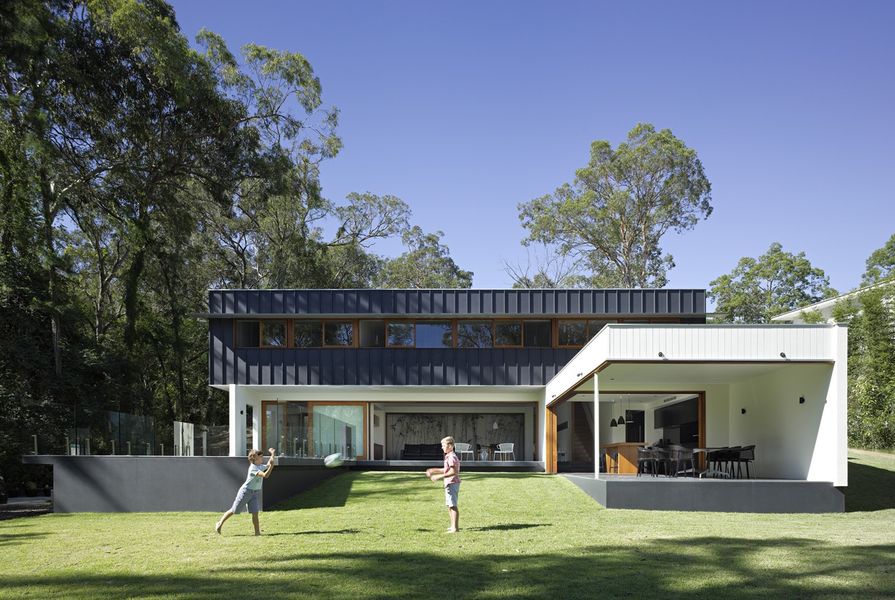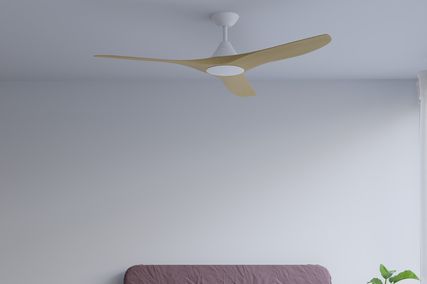A house is the sum of its inhabitants, its place and its history. A home is the culmination of lessons learned, influences distilled and artefacts gathered and displayed, as well as a reflection of the subtle idiosyncrasies of a particular family. Fig Tree Pocket House is the Plazibat family’s home, designed by architect Shane Plazibat in consultation with his wife Liz.
A sky-lit void separates sleeping from living areas.
Image: Christopher Frederick Jones
The Plazibat family has lived in the Brisbane enclave of Fig Tree Pocket for twelve years. Less than a kilometre away from the current site, on a sloping piece of bushland, Shane designed their first home. Later, when it was sold to secure the purchase of the current site, the family lived in a John Dalton-designed house close by. Over time, an affinity with their neighbourhood has deepened, and through practice and experience a catalogue of ideas has developed, as made evident in the design of this home.
In a conscious gesture, Fig Tree Pocket House anchors itself in the sloped terrain. This is unusual for Queensland, where tradition determines that a dwelling sits upon and overlooks the landscape. For Shane and Liz, the practical advantage of immediate garden access and the opportunity to connect to and enclose the site were guiding principles.
The house is approached along an easement on the high side of the site and is revealed obliquely by a presence that is low and long. The single-storey entry building is a space that can be used for tennis, ball games and car parking. It is connected to the upper level of the two-storey house proper by two bridges. At this juncture the land has been cut and retained, creating a void that sustains a vertical garden of bamboo.
Looking out across the kitchen.
Image: Christopher Frederick Jones
Spatially the house is divided between the bedrooms upstairs and living spaces downstairs. These rooms are arranged lineally, east to west, and connected by a long timber stair. The kitchen is the exception to the plan in that it is positioned independently as a single-storey pavilion to screen the western boundary. Along with the pool, it completes the enclosure of the lawn. The beauty of this arrangement is its simplicity and the way it has been positioned within the landscape to perfectly capture a northern aspect.
The living room, which is located centrally at ground level, makes the most of its orientation. It is the largest space in the house, made larger still when its long edges slide away and it spills forward onto the lawn. The back of the room opens to the double-height bamboo garden. This void works to expel warm air and to draw cool northern breezes through the house. The planting offers both climatic and visual relief, throwing afternoon shadows onto the wall to be captured in the framed aperture of the living room opening.
The living space extends to make a narrow verandah that floats over the lawn, transforming the terrace ledge into a bench seat. This encourages backyard cricket spectators and provides a space in which the family can assemble for casual gatherings. It is here, on the sun-soaked slate, that one might dry off after a swim before collecting an ice-cream to enjoy on the lawn.
Carport and bedroom sections atop the sloping site.
Image: Christopher Frederick Jones
Upstairs, the bedrooms are balanced by generous bathrooms and storage space. Each room is accessed from a corridor that opens to the bamboo garden below. This considered arrangement promotes natural ventilation, good daylight penetration and efficiency of plan. At the end of the corridor, the bridge to the carport takes you past the laundry and connects you at the upper level to the outside.
Externally, the volumes of the house are distinguished through the use of materials: rendered blockwork, painted fibre cement sheets with cover battens and New Guinea rosewood timber-framed windows. On the northern facade a long aluminium sun hood and continuous aluminium trim are used to amplify the horizontal composition of strip window openings. Stratification is achieved with colour, through a parallel exchange of charcoal and white.
The home withstands the test of functionality, seamlessly using concealed support spaces to maintain clarity of space. The small lounge adjacent to the living space is an example of this – it houses the television, removing it as the focus of the living room. The service galley plays the same game by accommodating the fridge and pantry, affording the kitchen a liberal disguise in the purity of ink-black granite and glass.
Without a specific environmental agenda, Fig Tree Pocket House poetically responds to the climatic demands of its bush setting. It achieves this passively and with the beauty and refinement of a house that may otherwise perform less effectively in this locale. The outcome is testament to the logic, restraint and consideration that have contributed to making such a liveable home.
Products and materials
- Roofing
- Lysaght Trimdeck roof decking with Zincalume finish; Kingspan Air-Cell R2.5 roof insulation.
- External walls
- Boral reinforced concrete block with sand/cement render, painted Dulux ‘Stowe White’; James Hardie HardieFlex wall cladding with cover batten painted Dulux ‘Domino,’ and Scyon Axon wall cladding painted Dulux ‘Stowe White’; Johnson Waringa tile (feature wall).
- Internal walls
- Boral plasterboard walls, painted Dulux ‘Antique White USA’, and spotted gum tongue-and-groove timber wall cladding with Sikkens Cetol TS Interior Mat Plus finish (feature wall).
- Windows and doors
- Logan City Joinery New Guinea rosewood windows and doors with Sikkens Cetol HLS/Cetol Filter 7 finish; Luxaflex Slimline venetian blinds in powdercoated silver; Madinoz window hardware.
- Flooring
- Classic Ceramics Brazilian slate floor tiles in Ebony/Midnight Blue; Boral spotted gum tongue-and-groove flooring with Sikkens Cetol TFF finish; Tuftmaster Carpets Paragon Twist wool carpet in ‘Yarwood’; Arden Architectural Stairs spotted gum stairs.
- Lighting
- Darkon Architectural Lighting Deep Down downlights; Flos Fucsia pendants and Miss K bedside lamps; Modular Duell wall lights; Louis Poulsen Satellite pendants and Moser pendant; Light Years Design Cecilie Manz Caravaggio pendants; Hunza spikes, wall lights and spot lights (external).
- Kitchen
- Miele stainless steel appliances; GMG Stone Indian Jet Black granite workbench top, polished; Resene Nero matt 2-pac finish to workbench joinery; Cronks Design glass splashback and spotted gum timber island bench with clear 2-pac finish; Gessi Oxygene tap; Abey Quadrato undermount sink.
- Bathroom
- Roca David Chipperfield Element freestanding bath; Vitra Matrix back-to-wall toilet; Duravit Foster wall basin; Methven Minimalist tapware; Madinoz hardware; GMG Stone Calacatta Oro marble ledge, honed; Classic Ceramics matt white wall tiles.
- External elements
- Thump pool fence; Classic Ceramics Brazilian slate tiles in Ebony.
- Other
- Kartell Philippe Starck Ghost stools and bedside tables, and Papyrus chairs; Academia Rope Easy chairs; Artek Alvar Alto dining table, chairs, stools and benches; King Furniture Barcelona chairs and Delta sofa in black.
Credits
- Project
- Fig Tree Pocket House
- Architect
- Shane Plazibat Architects
Fortitude Valley, Brisbane, Qld
- Project Team
- Shane Plazibat, Vincent Teo, Danielle Sturton, Jindrich Hozak
- Consultants
-
Builder
CGH Constructions
Engineer Westera Partners
Joinery Cronks Design
Lighting Light and Design Group
Pool Baldwin Aquatic
- Site Details
-
Location
Fig Tree Pocket,
Brisbane,
Qld,
Australia
Site type Suburban
Site area 2000 m2
Building area 400 m2
- Project Details
-
Status
Built
Design, documentation 12 months
Construction 9 months
Category Residential
Type New houses
Source

Project
Published online: 16 Jul 2012
Words:
Michelle Bailey
Images:
Christopher Frederick Jones
Issue
Houses, April 2012

























